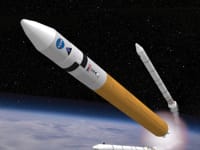NASA's Langley Research Center has developed a new adhesively bonded joint concept for curved and flat panel sandwich architectures. A woven preform, inserted into the seam between sandwich panels, provides a larger total bonding area and multiple load paths for an improved distribution of load through the joint. NASA is able to create structures by joining sections of sandwich panels or curved shells. The new joint provides more durable load transfer and redundant load paths compared to current state-of-the-art adhesively bonded strap joints.
Benefits
•Increased safety factor: reduced stress concentration on the joint
•Dual bond line for mitigation of manufacturing defects: redundant load path allows load redistribution in the case of partial joint failure
•Improved mass-efficient load transfer capability that can be tailored for specific applications
•Decreased circumferential load strains compared to a conventional strap-type joint
•Cost and time savings in producing the preform insert as a single piece and later co-bonding the joint into place
•Overlap length: additional bond area allows for decreased bond length (which translates into lower mass structures) when compared with a conventional strap or H-type joint
Applications
•Aerospace joining composites for -- Heavy lift vehicle segments -- Wing sections or wing boxes the strongest structural area of the aircraft, which suffers the most
•Wind Power - turbine propeller construction
The Technology
FIGURE 1 - Detailed description of (a) single, and (b) DRJ adhesively bonded joint architectures. All face sheets and splice plates are solid laminates composed of unidirectional laminas
FIGURE 1 - Detailed description of (a) single, and (b) DRJ adhesively bonded joint architectures. All face sheets and splice plates are solid laminates composed of unidirectional laminas
NASA is developing next generation launch vehicles that will be based on high-performance composite materials and innovative manufacturing methods. As such,
NASA uses adhesively bonded joints where possible, instead of mechanically fastened
(bolted) joints, to design and manufacture structures. The adhesive joints are typically
lighter and distribute loads more efficiently across an interface, while mechanically
fastened joints are prone to stress concentrations around the bolts. The new durable
redundant joint (DRJ) offers improved safety and load carrying capability for sandwich
structures when compared to conventional H-type joints. The DRJ uses a composite
preform to connect two ends of a curved, composite sandwich panel to form, for
example, a cylindrical vehicle segment. Figure 1 shows the cross sections of two
adhesively bonded joints--the single and the DRJ, including the preform.
NASA has performed detailed finite element modeling of the new joint architecture
to obtain initial indications for the structural response to a simplified hoop loading.
Results indicate that
-- the DRJ provides an improved stress-strain response without a severe mass penalty,
-- peak stresses are independent of the joint overlap length, and
-- the DRJ will redistribute a load to accommodate joint damage or
manufacturing defects.
Video
Like this entry?
-
About the Entrant
- Name:Kimberly Middleton
- Type of entry:teamTeam members:Stanley S. Smeltzer (NASA LaRC)
Eric Lundgren (NIA) - Patent status:patented





